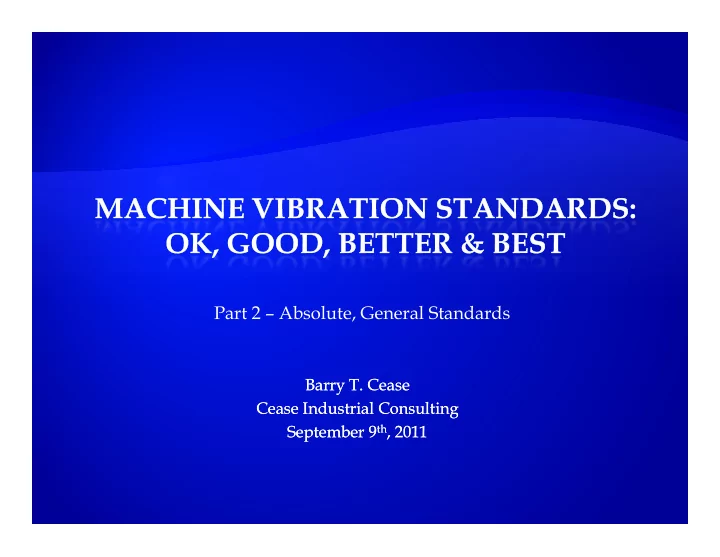

Part 2 – Absolute, General Standards Barry T. Cease Barry T. Cease Cease Industrial Consulting Cease Industrial Consulting September 9 September 9 th th , 2011 , 2011
1) ABSOLUTE, GENERAL (OK) 2) ABSOLUTE, MACHINE SPECIFIC (GOOD) 3) COMPARATIVE (BETTER) 4) HISTORICAL STANDARDS (BEST) 2 Cease IndustrialConsulting MachineVibration Standards: Ok, Good, Better & Best
These standards represent a starting point or rough gauge to apply to most machinery using an absolute vibration reference level by machine condition that is based on both experience & historical data across many industries and machine types. Some examples are as follows: 1) IRD 10816 Charts (Casing Measurements) 2) Bernhard Chart (Casing Measurements) 3) Vibration Institute Standards (Casing Measurements) 4) Update International Standards (Casing Measurements) 5) 5) Blake Chart (Casing Measurements) Blake Chart (Casing Measurements) 6) ISO 10816-1 Standard (Casing Measurements) 7) API 612 Standard (Shaft Displacement) 8) Dresser-Clark-Jackson Chart (Shaft Displacement) PROS: No prior machine history is required to perform a general assessment of a machine’s health. CONS: Fail to account for the vast differences between machine types, bearing types, stiffnesses, system mass, base types, machine speeds, loading, etc. 3 Cease IndustrialConsulting MachineVibration Standards: Ok, Good, Better & Best
• At or below 0.08 ips-pk is good for general good for general machinery. • At or above 0.314 ips-pk is rough for general machinery. 4 Cease IndustrialConsulting MachineVibration Standards: Ok, Good, Better & Best
• About 1 g’s-pk or below represents good operation for most machinery. machinery. • About 3 to 4 g’s-pk represents the limit of good to fair operation for most machinery. 5 MachineVibration Standards: Ok, Good, Better & Best Cease IndustrialConsulting
Velocity: 1) Below 0.20 ips-pk is considered good to fair. 2) Above 0.20 ips-pk is considered rough. Acceleration: 1) Below 3 to 6 g’s-pk is considered good to fair. 2) Above 6 g’s-pk is considered rough. Foundation Type: Suggestion is made to reduce measured levels by 40% to compensate for isolated or weak foundations. 6 Cease IndustrialConsulting MachineVibration Standards: Ok, Good, Better & Best
Vibration Institute, General Standards Vibration Institute, General Standards [8] [8] Update International, General Standards Update International, General Standards [9] [9] Machine Condition Overall Vibration, Overall Vibration, Machine Condition Overall or 1x RPM Higher Frequency RMS Velocity Peak Velocity Vibration Level Vibration (Bearing (ips-rms) (ips-pk) Frequencies) Acceptance of new < 0.08 < 0.16 Dangerous 1 0.4 or repaired equipment equipment Very Bad Very Bad 0.6 0.6 0.2 0.2 Unrestricted < 0.12 < 0.24 Bad 0.3 0.1 operation – normal Surveillance 0.12 – 0.28 0.24 – 0.7 Mildly Rough 0.2 0.07 Unsuitable for > 0.28 > 0.7 Good, Acceptable 0.1 0.04 operation Very Good 0.05 0.02 0.01-0.02 0.005 Precision, Very Smooth 7 MachineVibration Standards: Ok, Good, Better & Best Cease IndustrialConsulting
Velocity: 1) Below 0.06 ips-pk No Fault. 2) Below 0.20 ips-pk Minor Fault. 3) Above 0.20 ips-pk Some Fault. 4) 4) Above 0.63 ips-pk Acute Above 0.63 ips-pk Acute Fault. 5) Above 2 ips-pk Danger. Acceleration (Freq. Dependent): 1) Below 1 g’s-pk No Fault. 2) Below 2-3 g’s-pk Minor Fault. 3) Above 10 g’s-pk Acute Fault to Danger. Service Factor provides a way to adjust levels for machine criticality. 8 Cease IndustrialConsulting MachineVibration Standards: Ok, Good, Better & Best
"Derived Peak" RMS Vibration RMS Vibration Vibration Velocity (mm/s) Velocity (ips-rms) Velocity (ips-pk) Class 1 Class 2 Class 3 Class 4 0.28 0.01 0.02 A A A A 0.45 0.02 0.03 A A A A 0.71 0.03 0.04 A A A A 1.12 0.04 0.06 B A A A 1.8 0.07 0.10 B B A A 2.8 0.11 0.16 C B B A 4.5 0.18 0.25 C C B B 7.1 0.28 0.40 D C C B 11.2 0.44 0.62 D D C C 18 18 0.71 0.71 1.00 1.00 D D D D D D C C 28 1.10 1.56 D D D D 45 1.77 2.51 D D D D Zone A - Newly commissioned machinery. Excellent Condition. Zone B - Good. Acceptable for unrestricted, long-term operation. A complete copy of this Zone C - Unsatisfactory for long-term, continuous operation (alert level). vibration standard is Zone D - Bad. Sufficient severity to cause long-term damage to machine (alarm level). available from the ANSI website at the following: Class 1 - Very small machinery or parts of machinery (20 HP or below). http://webstore.ansi.org/ Class 2 - Small machinery (20-100 HP) on rigid foundations. Class 3 - Large machinery mounted on rigid & heavy foundations. Class 4 - Large machinery mounted on relatively soft foundations. 9 MachineVibration Standards: Ok, Good, Better & Best Cease IndustrialConsulting
• The API 612 specification offers a quick way to gauge the severity of shaft vibration in displacement (mills-pk-pk). • Often used when commissioning new commissioning new equipment for service. • The spec is simply given by applying the formula shown at right. • All you need to know is the machine rpm to obtain the spec. 10 MachineVibration Standards: Ok, Good, Better & Best Cease IndustrialConsulting
• The Dresser-Clark- Jackson chart like the API spec gives a quick, overall assessment of machine condition if the machine rpm is known. • Results are similar to those from the API spec. 11 Cease IndustrialConsulting MachineVibration Standards: Ok, Good, Better & Best
6) IRD Mechanalysis, Vibration Technology 1 Manual, Chapter 2, Basics Of Vibration, IRD Mechanalysis, 1988 Bernhard, David, Machinery Balancing, 2 nd Edition, Chapter 1, Vibration 7) Fundamentals, David Bernhard, 1998 8) Eshleman, Ron, Basic Machinery Vibrations, Chapter 5, Machine Condition Evaluation, VI Press, IL, 1999 Evaluation, VI Press, IL, 1999 9) Buscarello, Ralph, Practical Solutions to Machinery & Maintenance Vibration Problems, p. 156, Vibration Tolerances, Update International, CO, 1991 10) ISO 10816-1, Mechanical Vibration – Evaluation Of Machine Vibration By Measurements On Non-Rotating Parts – Part 1: General Guidelines, First Edition 1995-12-15, ISO, Switzerland, 1995 11) American Petroleum Institute, API 612 - Special Purpose Steam Turbines for Refinery Service, Washington, DC, 1987 12 Cease IndustrialConsulting MachineVibration Standards: Ok, Good, Better & Best
Recommend
More recommend